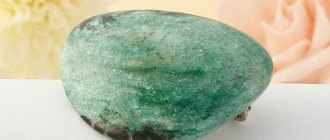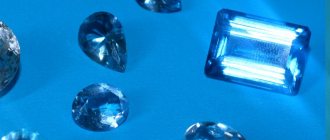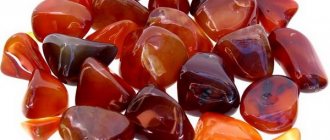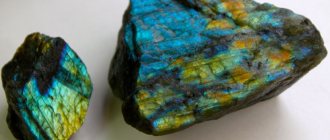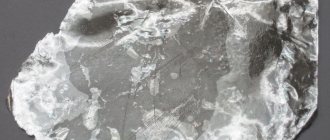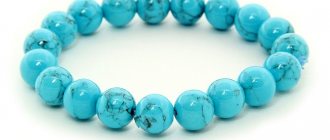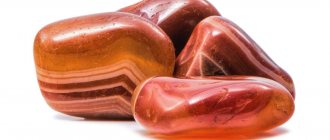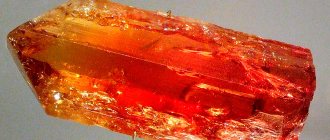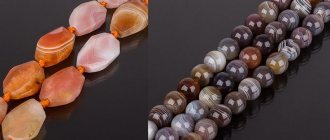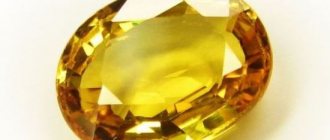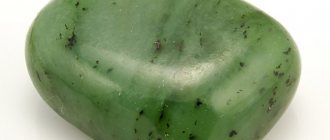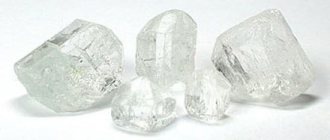Lapis lazuli - from the Arabic word “azul” - sky blue or “blue stone” - as the Arabs call it. The main component is lapis lazuli - 25 - 40%, other minerals are also present, for example, augite, calcite, diopside, enstatite, mica, hauin, hornblende, nosean, pyrite. Lapis lazuli is considered as a rock and should not be considered a synonym for lapis lazuli. Lapis lazuli itself is unstable to high temperatures and acids.
High quality stones have color evenly distributed. There are spotted and banded stones. Lapis lazuli from Chile and Russia has a strong grayish calcite. Stones with uniform inclusions of pyrite are most valued, but an excess of the latter causes a greenish tint. The brightness of the color of the stone can be enhanced by slight heating and additional coloring.
Lapis lazuli. Synonym: ultramarine.
Lapis lazuli is an opaque stone. Unstable to heat and acids. Color – all blue shades – azure blue, violet, greenish blue…
The brighter and more saturated the color, the higher the value of the stone. And, as you know, the blue color attracts and excites the imagination, because when we look into the blue sky, we always think about something sublime and mysterious.
Hardness 5-6 Density – 2.5 – 3.0 Pleochroism – absent
Be that as it may, the name we most often come across is lapis lazuli stone. The luster of lapis lazuli ranges from glassy to greasy. Lapis lazuli is fragile and can be easily polished. Golden inclusions of pyrite against a blue background give polished lapis lazuli a look reminiscent of a starry night sky.
The deposit, which is more than 6,000 years old, is located in Afghanistan in the Hindu Kush mountains. There are several varieties of lapis lazuli - from indigo blue to sky blue, and there is also greenish blue. In Russia, lapis lazuli is mined in the Baikal region. There are deposits in Tajikistan, Chile, Angola, China, Canada, Pakistan, and the USA.
In the Middle Ages, lapis lazuli was used to make ultramarine paint. Some surviving palaces and temples of that time are decorated with lapis lazuli mosaics. Lapis lazuli is a fabulously beautiful blue stone. Probably due to its blue color, lapis lazuli has long been considered a sacred stone. He was one of the favorite and revered gems. Some researchers even suggest that in ancient written sources the name sapphire meant lapis lazuli.
In excavations of ancient civilizations, lapis lazuli beads and pharaonic masks are found. Lapis lazuli was seen as a symbol of power, so in China it was used to decorate the headdresses of emperors, and Chinese women used lapis lazuli beads to decorate their thick, black hair. Lapis lazuli was valued higher than gold in China. The palaces of eastern rulers were decorated with it, and the stone became the object of attention of merchants and ambassadors. Gradually, the rulers and nobility of Europe began to decorate their palaces with statues, fireplaces, and vases made of lapis lazuli.
Nowadays, lapis lazuli is used both in jewelry - rings, necklaces, earrings, bracelets, brooches, beads, and in sculpture, interior design and other handicrafts.
There are imitations with pieces of lapis lazuli, pressed and glued with synthetic resin. There is also synthetic lapis lazuli of fairly good quality. Lapis lazuli is often imitated by painting various white stones or jasper ("Swiss lapis") blue. An imitation of lapis lazuli is obtained by dyeing synthetic spinel blue.
How to distinguish natural lapis lazuli from imitation?
You need to wet the stone. If it is real, its surface will be evenly moistened; if it is fake, water will collect in drops. Real lapis lazuli is beautiful only in bright sunlight; fakes shine even under artificial light.
The healing properties of lapis lazuli and stone treatment
In ancient times, people believed that this soft and fragile stone could save a person from poisoning. It was ground into powder and added to medicinal mixtures. He was also credited with curing ulcers of internal organs. Also, ancient doctors claimed that if you look at a stone for a few minutes a day, you can improve your vision.
A person will not believe anything, just to return the most precious thing - the seeing eyes. And in our time, we should not forget the recipes of our ancestors and use everything available in parallel with trips to microsurgery. The possibility that lapis lazuli beads will normalize blood pressure and calm the nerves is possible, but most likely, if you have not delayed it to the point of chronic hypertension. In any case, lithotherapists recommend lapis lazuli jewelry, which will distract from bitter memories and grievances.
If you contemplate beauty in the hope of healing, then most likely you will gain a positive attitude and learn to better understand and feel other people. Which means you will be happy. Therefore, lapis lazuli, of course, belongs to those stones that can be called a stone of goodness and love. What do astrologers say? Lapis lazuli is a stone that suits all zodiac signs, perhaps only Capricorn and Cancer are indifferent to it.
Magical properties of lapis lazuli
In ancient times, lapis lazuli was a reliable amulet. Many believed that when going into battle, you should take an amulet made of lapis lazuli with you, then the warrior would be under reliable protection. At the same time, lapis lazuli was a desirable stone as a gift in diplomatic relations.
Historical reference
Once upon a time in the East, where Afghanistan borders on Tajikistan, ancient people mined marble, which was the main material for the construction of ancient temples and palaces. It was there, in an area called Badakhshan, that workers discovered bright blue inclusions of lapis lazuli in marble blocks.
The emirs of that area declared the nugget to be of rare value. The slaves who mined the stone were chained to the walls of the mines in order to prevent the possibility of theft of lapis lazuli. Since that time, the peoples of the eastern steppes and mountains have revered the mineral as a symbol of the supreme deity Tengri-Sky.
The discoverers of stone used it for cladding palaces and temples. Later, from Afghanistan, the heavenly mineral gradually fell into the hands of the Persians, and then to the Egyptians. Crossing ancient Greece and Rome, lapis lazuli gradually found its way into the hands of Europeans.
- The ancient Egyptians associated lapis lazuli with the main god Amon-Ra, considering the stone a symbol of the highest heavenly justice. Therefore, the judge of ancient Egypt wore a breastplate made of stone with the hieroglyph “truth” carved on it. Products made from lapis lazuli were placed in the tombs of Egyptian pharaohs. One of the ancient rulers in whose burial chamber lapis lazuli jewelry was found was Tutankhamun.
- The Chinese and residents of other Central Asian states symbolized the blue nugget with the power of monarchs and Heaven, which stretched over every person, regardless of who he was - a mandarin, emir, peasant or warrior. There is a belief that it was from Badakhshan lapis lazuli that the boards of Moses were made, on which the prophet inscribed the commandments sent down by heaven.
In addition to its use in construction and symbolism, lapis lazuli has long been used by artists of the East and West as a colorful material. Ultramarine, a bright blue paint based on resin, water or tempera, was made from the mineral crushed into powder.
The name of the nugget has also come a long way. The Persians called the mineral “heavenly stone” or “lazhvard”. And in Europe, as in Russia, until the 18th century the mineral was called by the Latin name “lapis lazuli.” The fame of the nugget in Rus' began during the reign of Ivan the Terrible. The Russian-language names for the stone of that era were “lazurik” and “lazorevik”.
Interesting facts about lapis lazuli
There are many interesting facts about lapis lazuli. The most interesting of them include:
- in ancient times, lapis lazuli was a symbol of sincerity and divine favor;
- in Europe, the blue tit was a sign of prosperity, good luck and success;
- in India it was believed that lapis lazuli brings love and prosperity;
- in China, lazhvard was a symbol of imperial greatness;
- products made from lapis lazuli were placed in the tombs of Egyptian pharaohs (one of them was discovered by archaeologists in the tomb of Tutankhamun);
- smuggling and sale of this stone in Afghanistan is the main source of income for the Taliban movement, as well as the cause of corruption in the government of the country;
- It is believed that the 10 commandments sent down to the prophet Moses are inscribed on lapis lazuli boards.
- In ancient times, lapis lazuli symbolized sincerity, as well as talent and divine favor. In Europe, the stone became a symbol of well-being, good luck and success, and among the people of India - love and prosperity. The ancient Egyptians used lapis lazuli to establish a connection with the gods, making special coloring mixtures for priests based on lapis lazuli. Scarab beetles were also carved from this mineral. And among the Chinese, lapis lazuli was a symbol of imperial power.
- Illegal mining and sale of lapis lazuli in Afghanistan is considered one of the largest sources of income for the Taliban movement, and the cause of corruption in government structures.
Physical and chemical properties
Lapis lazuli stone
Characteristics: lapis lazuli is a complex compound of aluminum, sodium, silicon, sulfur and oxygen. The composition may contain calcium, individual inclusions of feldspars and pyrite. Belongs to the subclass of frame aluminosilicates. A rock-forming igneous material released from magma very low in silica.
Hardness 5.5. Can be scratched with a knife made of alloy or carbon steel. Doesn't scratch glass.
The rich blue color of lapis lazuli is due to the presence of sulfur in its composition, which partially replaces silicon. Sulfur content - up to 0.7%. The higher it is, the thicker and brighter the color.
Lapis lazuli crystal is a rare occurrence. The usual form of its occurrence in nature is veins in marble or massive blocks. In turn, lapis lazuli can have golden veins, which in ancient times were considered true gold. But this is pyrite, also known as sulfur pyrite, iron disulfide. The blue tit is not a gemstone.
The properties of lapis lazuli make it easy to process, but also easy to damage.
| Formula | Na[(AlSiO4)SO4] |
| Color | Shades of blue |
| Shine | Glass |
| Transparency | Translucent |
| Hardness | 5,5 |
| Cleavage | Implicit |
| Kink | Conchoidal, granular |
| Density | 2.38 - 2.42 g/cm³ |
A little history
About 8 thousand years ago, serious excavations of lapis lazuli first began in the mountain system in the south of Central Asia and the north of the Himalaya mountain range. Blue stone was used to decorate the palaces of the most important eastern kings. Such a touch in the architectural design meant that the crystal was rare, since not everyone could afford to decorate their house with lapis lazuli. Of course, ambassadors and merchants from different countries looked at this phenomenon with curiosity. Artists in Western Europe have found very interesting uses for the blue mineral. Due to the fact that the stone is quite fragile, they turned it into a powder mass using special tools. Next, boiled oil was added to this powder, mixed, and ultramarine paint was obtained.
Lapis lazuli was also extremely popular among the Egyptian pharaohs. The most luxurious works of art of ancient Egyptian masters flaunt an abundant accumulation of blue stones. The ancient Egyptians used the mineral as decoration in almost all areas: pendants, rings, architecture, paintings, sculptures, etc. It was Egypt that brought to other countries such a tradition as creating jewelry only with the help of gold and inserts from lapis lazuli stones.
The color of the stone is very rich and is famous for the fact that its charming shade is natural
Thanks to the fact that the East was subjected to a series of conquests, the nobles of Europe gained access to an almost unlimited amount of blue stone. At their disposal, in addition to the huge reserves of the mineral in the eastern lands, there were huge sources of its extraction. The most significant people in Europe decorated their homes with all kinds of architectural objects made of stone: sculptures, statues, fireplaces, vases, etc.
However, lapis lazuli is a lapis lazuli crystal that has a uniform color. Such stones were highly valued and were not used in many areas as jewelry. Lapis lazuli was used only to create elite jewelry for the highest ranks.
Due to the fact that Russian territories were explored at one time, a huge accumulation of minerals was discovered there. This discovery made it possible to build unimaginable structures and buildings in the capital itself, which were finished only with a large number of stones. St. Isaac's Cathedral is famous for its columns, which are completely shiny and shiny with lapis lazuli finish. The list of the most magnificent buildings with blue stone includes the Peterhof Palace and the Winter Palace of the Emperor.
The most ancient stone among lapis lazuli is considered to be Badakhshan lapis lazuli, which was discovered in the lands of Afghanistan in Badakhshan.
Place of Birth
Lapis lazuli stone from Afghanistan interspersed with pyrite and calcite.
The oldest place is the border of the northern part of Afghanistan and Tajikistan: Badakhshan province. Work is still underway there, and the profit is provided by the Taliban movement and political figures.
Since lapis lazuli is of volcanic origin, it is mined in places where there were previously volcanoes:
- In Russia, the Baikal region (southern part) is considered the place for blue tit production; a lot of it was found along the banks of the Slyudyanka River. The appearance of the crystals is very similar to those from Badakhshan, but the pattern is a little blurry.
- There is another Afghan deposit, near the Pamir Mountains, but the minerals there are not of the same high quality as those from Badakhshan.
- Lapis lazuli is also mined in other countries of the world: Africa, Chile, Namibia, India, China, but the quality there is also not very high and the value is less.
Mining locations
The first deposit of the mineral is on the border between Northern Afghanistan and Tajikistan. To this day, Badakhshan province is famous for its lapis lazuli mining, providing financial support for the local Taliban movement.
In the 18th century, a Russian blue tit deposit was discovered along the banks of the Slyudyanka River, in the southern part of the Baikal region. The search for the heavenly stone was carried out on the initiative of Empress Catherine II.
Another deposit near Afghan deposits was discovered among the Pamir Mountains at the beginning of the twentieth century. More modest deposits are located in China, Chile and Africa.
Colors and varieties
The mined mineral is not always of a heavenly hue. There are stones of blue and deep blue color. There are minerals with a greenish tint, as well as violet-lilac specimens. The color of the stone can be either uniform or complemented by blots, “eyes” or sheets of various inclusions - pyrite, gray or white spar. Lapis lazuli with veins of feldspars is considered a low-grade material.
The most valuable material is considered to be Badakhshan lapis lazuli. The national stone of Afghanistan is divided into three varieties:
- Niili. The stone is a deep blue color. It can be plain or with pyrite veins.
Lapis Lazuli Niili
- Asmani. Sky blue mineral. It also comes in light blue.
Lapis Lazuli Asmani
- Sufsi. A nugget with a greenish tint and various inclusions.
Lapis lazuli Sufsi
Niili is considered the most expensive variety of Afghan lapis lazuli. The price of such a processed stone inserted into a product reaches 10 US dollars per gram. Sufsi is the cheapest subspecies.
Lapis lazuli from the Russian Baikal region is close in color palette to the Badakhshan mineral. The blue tit from the Pamirs and Chile is paler.
Price
Lapis lazuli is considered a semi-precious or ornamental stone. The price is determined in grams, not carats, and does not exceed $2 per gram (or $0.4 per carat). The best samples are used as jewelry. Gems, rings, pendants, earrings with inserts are cut from them, and sets are assembled. The mineral is cut into a cabochon and placed in a gold or silver frame. Inexpensive mass-produced beads cost $10–20.
Jewelry made by the author in a single copy is valued higher than products with a first-row gemstone.
Healing properties
A vase made of lapis lazuli at the Kremlin exhibition in 2011.
In the Middle Ages, crushed lapis lazuli was often used as an antiemetic for poisoning. This powder really has healing properties that are similar to the mechanism of action of activated carbon. However, today no one uses the gem like that. This is due to the high cost of such treatment.
However, modern lithotherapists often use lapis lazuli. Today its ability to restore visual functions is known. To do this, it is recommended to systematically peer into the crystal. It is recommended to do this at least twice a day for 10-15 minutes. In addition, the mineral has other valuable characteristics:
- Pendants and necklaces with lapis lazuli help normalize emotional background. They are great at managing the physical symptoms of stress. These include tachycardia, rapid breathing, and a feeling of a lump in the chest.
- Earrings or a pendant with a mineral help strengthen hair. These decorations help make them thicker, shinier and stronger.
- The mineral copes well with disruptions in the functioning of endocrine organs. Lapis lazuli helps improve a person's condition with diabetes or thyroid pathologies. At the same time, it is strictly forbidden to refuse the help of official medicine, since there is a risk of a significant deterioration in health.
- Lapis lazuli also copes with pathologies of the respiratory system. It is useful to wear a pendant or necklace during periods of relapse of bronchial asthma, pneumonia or bronchitis.
- A bracelet with a gem helps normalize cardiac functions. In this case, the jewelry should be worn on the left hand - in the place where the pulse is felt. An energy meridian is directed from this point to the heart, the functions of which are activated due to the healing characteristics of lapis lazuli.
To fully demonstrate the healing properties of the mineral, it is recommended to wear it daily for at least 2 hours. This should be done for 10-15 days. At the same time, it is impossible to refuse official methods of treatment. Any disease is a complex phenomenon. Therefore, it needs to be treated on a physical and energetic level.
Magical properties of lapis lazuli
Lapis lazuli has long been considered a symbol of friendliness, sincerity, purity of thoughts, serving as an instrument of white magic. The magical power of the nugget acts both on the consciousness of its owner and on the thoughts of the people around him. The mineral helps the owner make the right decisions and live according to the will of his conscience. The stone involuntarily diverts people who want to harm the owner of the gem from a bad idea. The mineral protects a person from envy, intrigue, damage and other negativity.
This is interesting!
The magical properties of lapis lazuli depend on the setting of the stone. The mineral in gold will enhance intuition and attract the attention of others, in particular, people of the opposite sex. Silver helps lapis lazuli protect a person from dark magic.
Lapis lazuli is endowed with an unusual ability - to change the world around us, the destinies of people. Anyone who wants life changes should acquire lapis lazuli jewelry - a bracelet or beads.
Such a talisman will help a person turn the thread of fate, for example, break off a painful relationship, move to another city or country, find a new job and make the necessary contacts. The mineral imparts wisdom, helps to make only the right decisions, which a person will not regret later. The power of the stone will help you forget past grievances and let go of the past.
Among the main magical capabilities of the heavenly stone is the cleansing of thinking from unnecessary “garbage”. Lapis lazuli makes a person calmer, cooler, promotes thinking, but at the same time slows down the reaction.
This contributes to the ideal compatibility of the mineral with people of such professions as priests, scientists or lawyers, that is, all those who need sober and unhurried thinking. Accordingly, such an influence makes lapis lazuli incompatible with people in business that require quick reactions - military personnel, rescuers, drivers, production workers, and so on.
Talismans, amulets, amulets
The stone can be worn under clothing or as jewelry. He is capable of collecting all the negativity directed by envious people or simply unkind people. When working in a team, it is better to have silver jewelry.
If the mineral is in gold, it will attract love and good luck to the owner. Beads, bracelets and pendants help to radically change your destiny.
If it is frameless, it can alternatively be carried in a handbag or in an inside clothing pocket.
If there are several stones in a product, then their cleansing power is enhanced.
Stone jewelry
High-quality specimens are used to make beautiful and inexpensive jewelry. In jewelry stores you can also find products framed in precious metals:
- Beads made of lapis lazuli. Round or faceted beads are used to create. They look beautiful in romantic looks, combined with flounces and ruffles.
- Rings with lapis lazuli in silver look like a work of art. They use frames of fantasy shapes.
- The bracelet is often assembled from small beads. Sometimes several gems are combined in one product. Lapis lazuli looks especially beautiful in combination with gold.
- Earrings with lapis lazuli in silver and gold make them massive and pretentious. They are suitable for special occasions. For daily wear, it is better to use studs.
- Pendant and pendant with lapis lazuli look good in combination with clothes with a deep neckline or on plain turtlenecks. Typically, such products have a thin frame (leather, silver, gold) and a massive stone.
- Rosaries and men's bracelets are made from small round beads. Usually crystals are combined with black leather.
- A woman's gold ring with such a stone usually looks more discreet than a silver one. The gold pairs beautifully with the sparkles of the pyrite in the stone. Recommended for special occasions, as a single decoration.
- A men's ring with lapis lazuli looks best in a closed frame in silver. The stone is usually given a square or rectangular shape
View this post on Instagram
Publication from Baikalkvartcsamotsvety (@baikalkvartcsamotcvety) Jun 23, 2021 at 6:38 PDT
View this post on Instagram
Publication from Baikalkvartcsamotsvety (@baikalkvartcsamotcvety) Jun 23, 2021 at 6:41 PDT
View this post on Instagram
Publication from natural stones (@sunstones_olena) Jun 22, 2021 at 12:41 pm PDT
Caring for stone and products
Fragile lapis lazuli requires careful handling. In order for it to maintain its attractive appearance for a long time, it needs to be properly cared for:
- Store in a separate box or box. Other jewelry may scratch it.
- After each wear, rinse under cold water.
- If the stone becomes dirty, it is washed with water and polished with a soft, clean cloth. If the dirt is very strong, use baby soap.
- It is important to avoid falling decoration onto the floor from a height. Otherwise it will break.
Areas of application
Lapis lazuli is the most famous blue mineral, which in its best examples has valuable decorative qualities. According to the classification of A. Fersman and M. Bauer, this mineral is classified as semi-precious ornamental stones of the first order. For comparison, it can be noted that the same (first) order of ornamental stones includes such materials as: jade, vesuvian, glauconite, sodalite, amazonite, labradorite, orlets, malachite, aventurine, quartzite, smoky quartz, rock crystal, agate (with its varieties), jasper, Hebrew stone and rose quartz.
Lapis lazuli eyebrows on the mask of Tutankhamun (1341-1323 BC), Cairo Museum
Of all the blue opaque stones known in ancient times, lapis lazuli was one of the most highly valued. This ornamental mineral was used to make amulets, vases, boxes and other expensive household items, as well as as a material for making expensive mosaics and inlays.
The modern name appeared only in the Middle Ages; in Pliny's time this stone was called sapphire.
Pliny gives this description of it:
“For sapphire also sparkles with specks like gold. It is also azure in color, although it is sometimes, but rarely, purple.”
In these words he describes in detail lapis lazuli, which has a blue color, sometimes modulating to purple, and very often contains scattered inclusions of pyrite, which in luster and color resembles gold.
In the Middle Ages, lapis lazuli was used in medicine and technology. In ancient medical manuals, recipes are constantly found according to which the so-called “Confectio Alkermes” were prepared from the grated substance, which, when taken orally in an amount of 20 or 25 grains, caused vomiting. Icon painters, as well as artists in later times, prepared (rubbed) expensive bright blue ultramarine paint from azure stone.
Lapis lazuli in jewelry
Tsarevich (Faberge egg) 1912.
Virginia Museum of Fine Arts, USA Jewelry lapis lazuli is a dark blue polymineral aggregate without visible light inclusions. Jewelry varieties include dense lapis lazuli in dark blue, cornflower blue and violet colors. Processed with cabochon or plates. In lower grades, spots of white, blue and gray are allowed, occupying, respectively, no more than 15% of the total surface area of the stone. In the most expensive lapis lazuli from Badakhshan (Afghanistan), golden sparkles of pyrite inclusions are common.
Lapis lazuli is used in jewelry as an inexpensive but beautiful ornamental stone. Lapis lazuli is a rather soft and brittle mineral, easy to process and polish.
Lapis lazuli can be additionally painted blue or imitated (fake) by painting white stones blue.
Decorative vases, boxes, and figurines are made from lapis lazuli. In the form of thin plates, they are used for inlay in artistic mosaic works, as well as for cladding columns, fireplaces, etc. One of the most valuable and most ancient mineral pigments.
Official seal of the President of Ukraine
The most expensive samples of high-quality lapis lazuli have long been considered the royal (imperial) stone and were used to make state regalia, royal household items and the highest gifts.
In particular, Mikhail Pylyaev writes that in 1873, during the stay of the German Emperor Wilhelm I in St. Petersburg, Alexander II made his august guest many rich gifts, including several vases and other decorations for the desk made from “lazure.” stone." Among these gifts, a miniature model of the monument to Peter I stood out with particularly fine workmanship, in which the rock was made of excellent lapis lazuli, and the statue itself was made of matte silver.
The handle of the official seal of the President of Ukraine is decorated with a lapis lazuli ball, resembling a photograph of the Earth from space (the texture of the stone gives this effect).
Types of mineral and its use
Like any other mineral, lapis lazuli is known for its healing properties. In ancient times, lapis lazuli powder was used not only by artists, but also by healers. The latter believed that with the help of this blue mineral powder it was possible to remove parasites and various poisons from the human body.
Healers of Medieval Europe assumed that the mineral was very effective in cases of exhaustion, since wearing any jewelry made from it helped to return to normal weight.
Today, many experts believe that lapis lazuli helps restore vision, and also allows the eyes to rest and relax. For these purposes, you just need to look at the mineral several times a day for five minutes.
Also, wearing lapis lazuli jewelry helps hair grow and prevents baldness.
Necklaces and beads made of blue gems help their owner cure hypertension, get rid of insomnia, nervous disorders, and nightmares. A pendant or brooch made of lapis lazuli saves its owner during attacks of radiculitis, relieves bronchial asthma and ulcers. The most powerful medicinal properties are lapis lazuli mined in Afghanistan.
A gem of a heavenly shade must be worn by people suffering from ailments of the respiratory system, including those with allergies. In addition, it is believed that the natural mineral is capable of purifying the blood, so in the past it was often applied to wounds, this ensured their speedy healing.
Lapis lazuli is classified according to the jewelry and decorative qualities of the mineral. There are such types of blue tits as niili, asmani, sufsi. They all have different values. The cost of lapis lazuli is largely influenced by its shade, which can vary from sky blue to blue-green.
The color of lapis lazuli depends on where it is mined. If the rock is mined in Afghan deposits, the lapis lazuli contains golden inclusions of pyrite. The color of the mineral mined on Baikal has various shades of blue with whitish stripes and inclusions, forming a beautiful intricate pattern.
| Classification sign | Types of lapis lazuli | Characteristic | Value |
| By color | Niili | Rich blue color, bordering on violet. Plain or with golden veins. | High |
| Asmani | Sky blue shade. There are light blue specimens. | Average | |
| Sufsi | Blue-green color. Possible inclusions. | Low | |
| By texture | Homogeneous | Uniform texture. Blue or purple color. There are no inclusions, spots or stripes. | High |
| Spotted | Bright color with small inclusions of foreign impurities. Heterogeneous structure. | Average | |
| Spotted with streaks | Combines the previous 2 types of minerals. |
Despite its fragility and low density, the scope of application of this stone is practically unlimited. Lazuli is widely used for making:
- Interior items. The stone is actively used for decorative purposes. Lapis lazuli of a deep blue hue is used to make floor and table vases, elegant candlesticks, boxes, and various figurines. Most often, spotted mineral is used for this.
- Jewelry. Thanks to its rich, noble hue, lapis lazuli is a stone that seems specially created for making jewelry. Rings, watches, brooches, earrings, and necklaces are made from it. Lazuli goes well with gold. Jewelry made from niili is especially highly valued.
This stone has another area of application. The mineral is used as a facing material. Countertops are made from it. Stone is also used to decorate the walls and decorate the external and internal elements of the premises.
People have long believed in the healing power of lapis lazuli. According to hereditary healers, wearing earrings, brooches, necklaces or bracelets with blue tits will protect a person from the evil eye and damage, give him mental strength and allow him to resist negative energy. The healing properties of lapis lazuli have found a place in modern medicine.
Its use helps:
- normalize blood pressure and nervous system function;
- facilitate the course of pregnancy and childbirth;
- prevent miscarriage and premature onset of labor;
- improve blood flow;
- stop the inflammatory process and pain syndrome of various origins;
- stimulate the activity of the thyroid gland;
- eliminate hyperthermic syndrome and signs of colds;
- strengthen the body's defenses;
- resist the effects of pathogenic agents;
- improve hair condition;
- stop the bleeding;
- accelerate the healing of wounds and abrasions;
- relieve attacks of bronchial asthma, as well as inflammation of the tonsils and respiratory organs;
- eliminate back problems, disorders of the digestive tract;
- improve visual function.
If there is no therapeutic effect when using lapis lazuli, most likely, errors were made during the application process. To achieve a positive result, you need to follow a number of recommendations:
- to improve visual acuity and get rid of heavy thoughts, continuously look at the nugget 2-3 times a day for 5 minutes;
- to normalize mental balance and sleep, wear a necklace with indigo-colored lapis lazuli;
- To stop hair loss and increase hair volume, wear earrings with lapis lazuli every day;
- to eliminate pain, apply blue tit to the sore spot 2-3 times a day for 5-10 minutes;
- to treat the respiratory system and relieve attacks of radiculitis, wear a pendant or brooch with lapis lazuli;
- to relieve attacks of bronchial asthma, wear a bracelet or ring with lapis lazuli on your right hand;
- to cleanse the lymph and eliminate inflammation of the lymph nodes, wear a ring with blue tit on your left hand;
- To ease the course of pregnancy and childbirth, as well as to prevent miscarriage, constantly wear beads with lapis lazuli.
Lapis lazuli is a semi-precious ornamental stone of the first order.
In jewelry, the greatest demand is for dark blue specimens without noticeable light inclusions, that is, dense dark blue, cornflower blue and violet lapis lazuli. They are processed with cabochon or plates. For low-grade stones, white, blue and gray spots are allowed. Expensive samples contain sparkles of golden-colored pyrite.
As a soft and fragile stone, lapis lazuli is very easy to process, and due to its beauty it is quite popular. In addition to jewelry, vases, boxes, figurines, inlays, and cladding are made from it.
Ground lapis lazuli is a natural ultramarine pigment known as lapis lazuli. Since ancient times, it has been widely used in painting to create oil paints, first in the countries of the East, from where it later became widespread in Europe, where it was especially popular among medieval artists. The pigment was used in painting until the beginning of the 19th century, after which it was replaced by a cheaper artificial analogue.
How to recognize a fake
Mechanical chronometer "Tuareg".
The clothes and headband are made of Afghan and Pamir lapis lazuli. The price of lapis lazuli is not too high; they are mostly counterfeited niili, which are quite expensive. On the other hand, the mineral itself is often passed off as more expensive stones - sapphire, sodalite.
How to distinguish a fake? Most often, lapis lazuli is imitated using painted glass or plastic. A more complex “art” is the refinement in laboratory conditions of a low-grade sufsi gem or azurite, similar to the heavenly stone.
If a scammer is going to pass off a mineral as a sapphire, then he will most likely simply rely on your ignorance of what lapis lazuli stone looks like and how it differs from more expensive rocks.
The most reliable way is to show the gem to a jeweler or geologist. But not everyone has this opportunity, so you will have to expose the scammers yourself.
- Natural minerals are rarely perfect. Under a magnifying glass, even on the most ideal crystal you can see scratches, cracks, and small inclusions.
- Immerse the jewelry in water. It will form drops on the plastic, and the natural stone will be evenly moist.
- The stone sparkles brightly in the sun's rays, but not in artificial light. A fake will always shine.
- If you squeeze the mineral in your fist, it will remain cold, but the glass or plastic will heat up from the warmth of your hands.
You need to check the authenticity of your jewelry not only to be sure that you did not buy a piece of plastic for the price of a stone. Only natural lapis lazuli has magical and healing properties. Never fake. If you bought a precious mineral and were given lapis lazuli, then, of course, you can use it as a talisman. But sapphire or sodalite have completely different energy and other magical features.
Product care
The average hardness and fragility of lapis lazuli make careful handling necessary. Otherwise, the texture – the pride of the stone – can be easily damaged. Stones such as lapis lazuli cannot tolerate:
- shocks, other mechanical impacts;
- sudden temperature fluctuations;
- accumulation of dust;
- prolonged exposure to the sun;
- home chemicals.
The structure of the mineral can be disrupted by newfangled ultrasonic cleaning. Wash jewelry with clean water and wipe with a lint-free cloth.
Stone compatibility
Lapis lazuli is one of the classic stones of the Earth. Other earthly rocks are jasper, jade, agates and chalcedony of all types and varieties, crocodile, malachite, turquoise, labradorite and morion. All these are opaque stones. Lapis lazuli is compatible with any of them.
A good combination is a company with Water gems:
- emerald;
- precious opal (except black);
- aquamarine;
- topaz;
- pearls;
- goshenite;
- peridot;
- euclase.
It is strictly unacceptable to combine with Fire - almandine, pyrope, grossular, all types of garnet, except demantoid and uvarovite. Particular attention should be paid to ensure that lapis lazuli does not get into the company of a diamond or ruby - they will “destroy” it.
The combination with Air - the mentioned demantoid and uvarovite, rock crystal and other clear quartz, rauchtopaz, golden beryl, amazonite, amethyst and chrysoprase - is neutral.
Compatibility
Lapis lazuli absolutely does not tolerate proximity to garnet, especially red shades. You should not wear it together with pyrope, grossular and almandine.
Friends with opal, pearl, peridot, emerald, topaz, aquamarine.
Who is lapis lazuli suitable for according to their zodiac sign?
Beads natural stone Lapis lazuli
Lapis lazuli and zodiac signs are not always compatible. This is an ideal talisman for people born on September 13th. The stone brings maximum benefit to Taurus, Sagittarius, Libra and Leo according to the horoscope.
Moreover, the more specific properties of the stone differ depending on the zodiac sign:
- Aries - for representatives of this sign, the stone is considered the real embodiment of love and family well-being. It helps to achieve tenderness and create a cozy atmosphere in the house. Lapis lazuli is especially suitable for Aries who are involved in charity work.
- Taurus - lapis lazuli is considered the real embodiment of success and helps to achieve your goals. The stone can be used as an amulet for Taurus women. It helps you achieve success in love and career. The heavenly stone provides special support to people who live according to the laws of justice. It can be used to improve financial well-being.
- Gemini - receive support from the crystal in all endeavors. A talisman that has a natural stone becomes a real embodiment of good luck and financial stability. It helps Gemini achieve success in their professional activities.
- Cancer - for them lapis lazuli becomes a real anchor on the path of life. Thanks to this mineral, it will be possible to avoid falling into a dangerous and risky path. In addition, natural stone has a beneficial effect on the emotional state of Cancers, provides protection against depression and aggression, and helps avoid self-absorption. With the help of this mineral it is possible to normalize mental balance and shift the emotional background in a positive direction. Pregnant women and people who are prone to depression have a special need for lapis lazuli.
- Leo is a stone that helps representatives of this sign normalize their emotional state. For them, the mineral becomes a real mentor. With its help, you can make informed and thoughtful decisions, as well as resist stress. It is permissible to carry the mineral with you as a personal talisman. Thanks to this, you can change your destiny for the better. Lapis lazuli also promotes the development of certain character traits - honesty, wisdom, nobility. This is a wonderful stone for travel.
- Virgo - this stone is required for those who are forced to constantly contact people. With its help, it is possible to reduce anxiety and cope with self-doubt. Lapis lazuli helps to facilitate communication with others and improve relationships with them. In addition, the stone helps to attract good luck to Virgos.
- Libra - lapis lazuli can be used as a talisman that helps protect physical and psychological health. The talisman also helps you achieve your goals and find your place in life.
- Scorpio is a mineral that improves the situation in the professional sphere and helps attract the right people into your life. With the help of the mineral it is possible to improve the character of representatives of this difficult sign.
- Sagittarius – representatives of this sign are recommended to wear lapis lazuli from time to time. It is best to wear jewelry with this stone when making vital decisions. The mineral helps to find new ideas. It can also help improve your health. The stone reflects favorably on people who are engaged in the creative field or help others.
- Capricorn - for people who belong to this zodiac constellation, lapis lazuli helps them find a kind of balance between eccentricity and seriousness. It helps direct the flow of energy to develop internal potential, helps strengthen willpower and increases self-confidence. The stone helps to seek life goals and achieve them.
- Aquarius - representatives of this sign can also use lapis lazuli as a talisman. With its help, it is possible to achieve harmony in the inner world, cope with fears and self-doubt. Lapis lazuli also helps overcome depression and despondency. If you use the mineral as a personal amulet, Aquarians will be able to improve their health and recharge themselves in a great mood.
- Pisces - the stone helps representatives of this sign maintain health. Real lapis lazuli helps Pisces cope with headaches and skin diseases. The mineral also improves mental state.
In general, lapis lazuli is considered a very positive stone that helps improve the lives of representatives of all zodiac signs. At the same time, he does not tolerate deception and resourcefulness well. You should not expect help for aggressive and unbalanced people. This talisman is suitable only for creative and noble individuals.
How to wear and care for a stone
Caring for lapis lazuli is easy. Avoid accidental impacts of the stone on hard objects, wash with clean running water (you can use household chemicals - the stone is resistant to acids and alkalis, except hydrochloric acid), store separately from harder stones in a soft bag.
You should wear lapis lazuli sporadically, no longer than 4–5 hours a day, if you do not need long-term meditation. From March 16 to 21, in the last ten days of Pisces, clean the stone with running water - river water, from a stream, etc. In the first decade of Aries, you can recharge any stone, including lapis lazuli, with the energy of Fire. To do this, circle the stone clockwise around the candle flame three times.
Sources and literature
- M. I. Pylyaev “Precious stones, their properties, locations and uses.” St. Petersburg, publishing house A. S. Suvorin, 1896
- A. E. Fersman “Stories about Gems”, second edition. — Moscow, “Science”, 1974
- S. F. Akhmetov “Conversations about gemology.” - Moscow, “Young Guard”, 1989.
- B. F. Kulikov “Dictionary-directory of semi-precious stones.” - Moscow, SME Publishing House, 2000.
- Anderson B. Definition of precious stones. - M.: Mir, 1983.
- Levi E. About the properties of stones or talismans. - M.: Strelets, 1900.
- Schumann V. World of stone. Rocks and minerals. - M.: Mir, 1986.
- Description of lapis lazuli on the Wikipedia website ru.wikipedia.org.
5 / 5 ( 3 voices)
Rules for wearing and care
When buying jewelry with natural minerals, you should take into account the favorable time to purchase a particular stone. For lapis lazuli, this is the week before the full moon.
Wearing the heavenly mineral constantly is not recommended . The maximum daily interaction time is 5 hours. Particular attention must be paid to energetic cleaning and recharging of the nugget. The first procedure is carried out during the last ten days of the sign of Pisces (March 16-21).
Also read: Rhodusite - mosaic stone
The blue tit is cleaned under running river water or water from a stream. In the days of the first decade of the Aries sign, it is advisable to charge the heavenly stone with fiery energy - move the mineral three times in a clockwise direction over a burning candle.
As for the rules of care, lapis lazuli is unpretentious. The main thing is to avoid mechanical damage and keep it in a separate bag made of soft fabric. You can wash the stone with regular clean water. In case of severe contamination, the use of cleaning agents is allowed, since lapis lazuli is resistant to acids and alkalis (in addition to hydrochloric acid).
